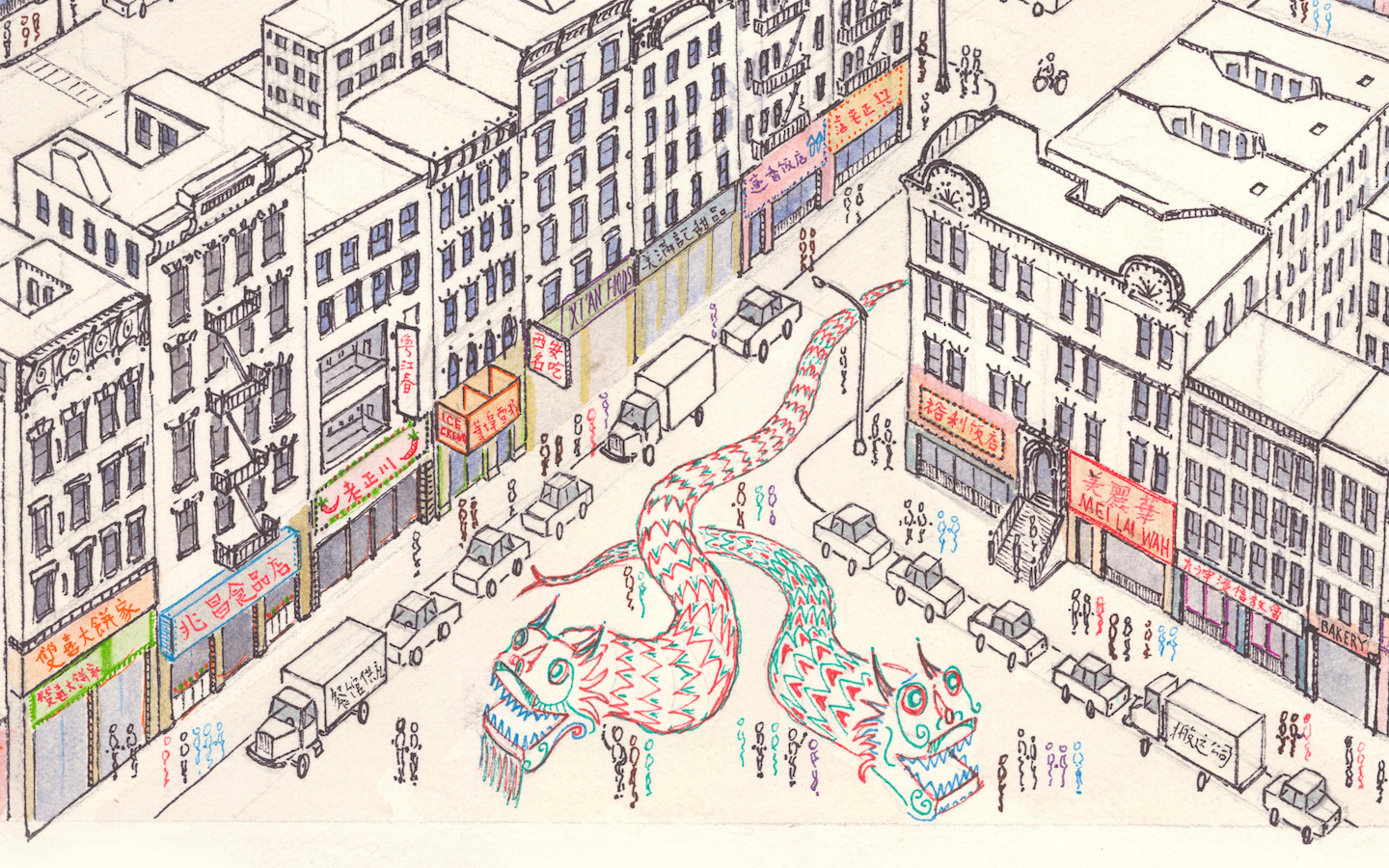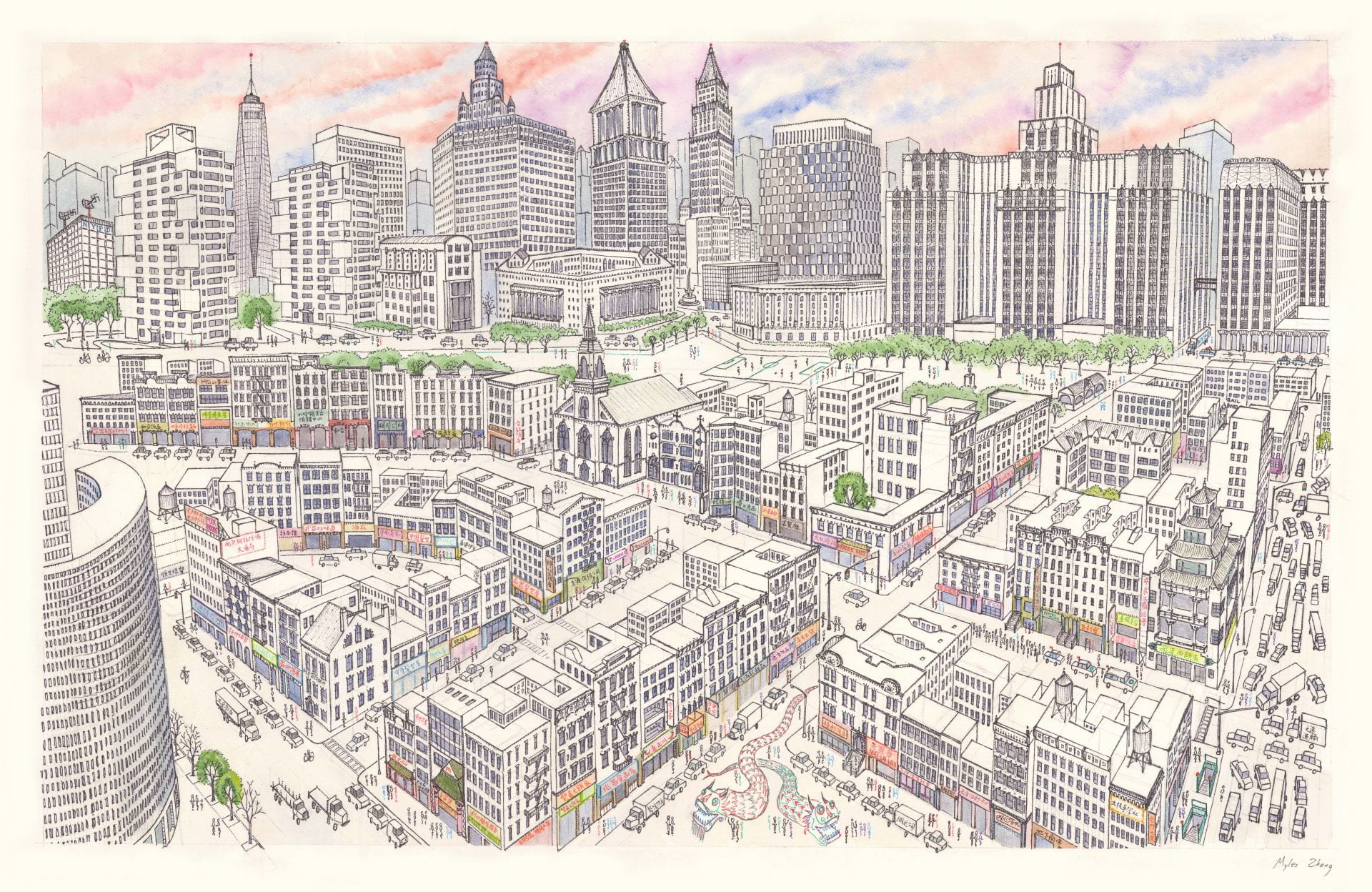.
Created with architect and urbanist Stephen Fan for City as Living Lab
Funded by the University of Michigan’s Rackham Program in Public Scholarship
Inspired by reading the book Manhattan’s Public Spaces:
Production, Revitalization, Commodification by Ana Morcillo Pallarés
.
Chinatown’s Public Realm
Along Mott Street, boxes of fruits and vegetables from the US, Latin America, and China flow from the private open storefronts and onto the public sidewalks and curbs. Forklifts navigate around crates and delivery trucks as vendors, residents, tourists, and shoppers–from regional Asian restaurant owners to West-African immigrants–animate the narrow walkways. After business hours, private produce stands become public places to sit, chat, people-watch, or nap as a sidewalk masseuse sets up two chairs on the public sidewalk to provide his private services.
Away from the commercial corridors, teenagers sit in circles sipping on bubble tea on the Pace High School track while senior citizens slap playing cards on a makeshift table along the track perimeter. Inside the Chinese Consolidated Benevolent Association, teachers begin their Chinese language class while protesters in Columbus Park call for ending violence against Asian Americans.
In creating this map, we hope to stimulate conversations about how public space can be better used, designed, managed, and reimagined: to inspire action in shaping a more resilient and inclusive public realm.
.
.
Read the map in English and Chinese PDF. 阅读简体中文版
2,500+ copies printed and distributed
.
.

Stephen Fan (left) and Myles Zhang (right)




Brochure Front

Brochure Back
.
Credits and Collaborators:
In alphabetical order
Stephen Fan – co-author
Lulu Barry – map docent
Kari Conte – CALL staff
Liza Cucco – program manager
Olivia Georgia – executive director of CALL
Shane Keaney – graphic designer
Rebecca Lucher – programs and operations
Mary Miss – founder and artistic director of CALL
Calla Flood Tardino – CALL staff
Chloe Zhang – map docent
.







Image Left

Image Center

Image Right
.
.
Process
This map illustrates the public/private uses/spaces of Manhattan Chinatown’s pedestrian life. The map is divided into two sections: the upper depicts public spaces, and the lower section private spaces. From left to right are a spectrum of private to public uses.
In consultation with Chinatown residents and based on a series of walking tours and community forums, we developed the themes and activities shown on this map. We were inspired from reading Jane Jacobs and Michael Sorkin’s descriptions of street life and the delicate balance of public vs. private uses that play out on the city sidewalks. We hope this map will be a classroom and community resource to equip the public with a language and questions to interrogate their own built environments.
Below are scenes from a community event we held in summer 2021. Chinatown residents were invited to annotate an early draft of our map with their experiences and memories of the community.
In addition, over spring and summer 2024, City as Living Lab commissioned two students as map docents – Lulu Barry and Chloe Zhang – to sit in front of the map each Friday and Sunday afternoon. They engaged in conversation at their table with passing Chinatown residents and tourists, sharing insights from the map and eliciting community responses to this project. Thanks to their work, this project now has a larger audience and copies of the map are distributed across dozens of Chinatown community partners.
.

Walking Tours and Community Meetings
From summer 2024

Walking tour with co-author Stephen Fan

Walking tour in Columbus Park with co-author Stephen Fan

Walking tour in Columbus Park with co-author Stephen Fan

Walking tour on Doyers Street with co-author Stephen Fan

Walking tour on the Bowery

Walking tour on the Bowery

Walking tour with co-author Stephen Fan

City as Living Lab

Walking tour with co-author Stephen Fan on Mosco Street
.
Chinese music: Feng Yang (The Flower Drum)
.








Inspired by this project. My observation is that the map captures the vibrancy of the Chinatown, yet, does not illustrate a major problem in the neighborhood – namely, the overwhelming amount of traffic on Canal Street and its tributaries such as Walker, Mott, Mulberry, and Bayard streets. A reduction in traffic and an increase in social space would help to transform the neighborhood in myriad positive ways. Recently, even during Chinese New Year celebrations, local residents and visitors had to jostle with endless traffic on Canal street just to make the new year celebration. We must prioritize the social space, the sidewalks, and the community of Chinatown over traffic and congested streets.
Any “map” of the public realm of Chinatown needs to incorporate the traffic disaster that is Canal Street and its tributaries so aggressively filled with automobiles. The public realm is everything from the building line to the next building line, and any objective look at Chinatown reveals that there is far too little space for pedestrians and far too much space for automobiles.
How to preserve the cultural character of Chinatown. Dismayed to see more souvenir shops replacing Asian businesses.